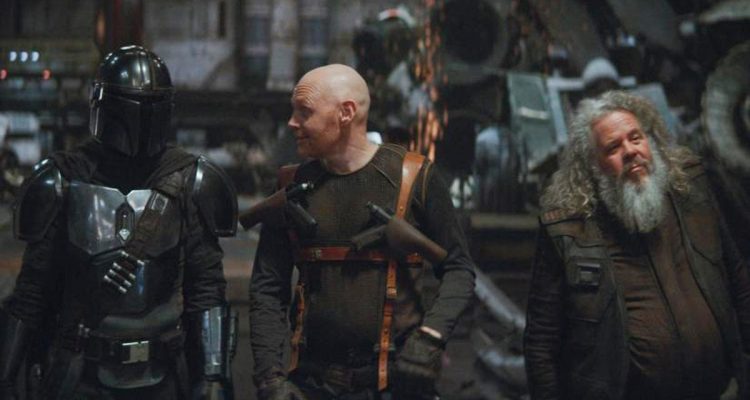“The Mandalorian” is unique for being the first live-action “Star Wars” television series, and at its best, it channels the relatively low-budget, let’s-put-on-a-show vibe of the very first movie and uses that potential limitation as a source for ingenuity, creativity, and small scale fun. The episodes are expensive (reportedly $15 million an episode), but still have a charming, handmade quality. Still, it’s easy to hanker for something bigger, grander, and more visually complex. That wish has been granted with the sixth installment of the first season (subtitled “The Prisoner”), the most rollicking and entertaining entry yet.
At the end of the last episode (a particularly fan bait-y affair set on Tatooine, written and directed by “Clone Wars” creator Dave Filoni) our strong, mostly silent central figure the Mandalorian (Pedro Pascal) left the dusty planet and, sadly, Amy Sedaris and her frizzy wig. As is customary, it was unclear where the Mandalorian was headed, although the series broke from its intensely focused POV, cutting back to Tatooine and a felled assassin (played by Ming Na-Wen). A shadowy figure, accompanied by the sound of jangling spurs (leading many to assume it was Boba Fett, freed from the Sarlaac on the same planet), investigated the downed killer before cutting to the end credits. This mysterious plot thread remains dangling as we head into this new installment; the unknown figure and whatever he or she was up to remains a mystery for at least another week.
Instead, the episode starts with the Mandalorian and his iconic, shiny ship the Razorcrest, arrive on a floating space station seemingly in the middle of nowhere. The Mandalorian meets with an old confederate, who promises him some cash if he helps out with a job. The job? Break somebody out of prison. The Mandalorian doesn’t like the gig, exactly. For one, there’s a droid on the job (a bounty hunter that looks a lot like 4-LOM from “The Empire Strikes Back,” only this one is voiced by Richard Ayoade); for another, they want to use his precious ship (“Looks like a Canto Bight slot machine,” says one of the criminals); and for a third, he doesn’t exactly get along with the gang leader played by comedian Bill Burr. Oh, and the transport ship they’re busting the inmate out of is a New Republic cruiser. It’s worth noting that Clancy Brown plays a gruff Devaronian, who you might remember as the devil-faced alien from the cantina in the first “Star Wars.”
Like the rest of “The Mandalorian,” this episode takes its cues from classic genre fiction; in this case the putting-together-a-team heist movie. Part of what makes the episode so fun is that it’s so unexpected — this show has been more beholden to old school westerns and samurai films so far. To engage with something slightly more modern is a refreshing change in pace, especially since it has a harder edge than, say, an “Ocean’s Eleven” in space. Once they get on the New Republic cruiser, too, the episode folds in contemporary science fiction from the time of the original film’s release, with flashes of “Escape from New York” and “Alien.” This is easily the most intense, edge-of-your-seat entry and by far the biggest. Even the classic “Star Wars” wipes feel suspenseful.
Most of this can be attributed to Rick Famuyiwa, the “Dope” filmmaker who directed episode two, “The Child,” which was the best and most satisfying episode up until this point. Famuyiwa isn’t afraid of humor and he isn’t concerned about pushing the show into areas that might not be classically “Star Wars.” He understands that the stakes on a live-action TV show doesn’t carry the same stakes as, say, a cinematic installment in the franchise, and he uses that latitude to try some really cool, crazy things. In particular, like in the earlier episode, he stages elaborate action set pieces with little-to-no dialogue, allowing the characterizations to come through movement, posing and elaborate stunt choreography. (This stuff is obviously too good to give away, but it’s good to know that him trying to trap his foes between automatic doors is one of the Mandalorian’s chief character traits.) It’s enough to make you wish Famuyiwa had directed more episodes (this is his last of the season and potentially the series); his episodes have a noticeably larger amount of verve and pop. Also, he gets great work out of Ludwig Goransson, who contributes darker, more electronically tinged melodies to this episode.
And honestly, thank god. The previous episode was good but sagged a little bit. This week, the sense of danger and strangeness returned and hopefully can carry through the final two episodes. It’s still unclear where, exactly, “The Mandalorian” is headed, but if the episodes are as great as this installment, it doesn’t matter much. Bring it on. [A]

